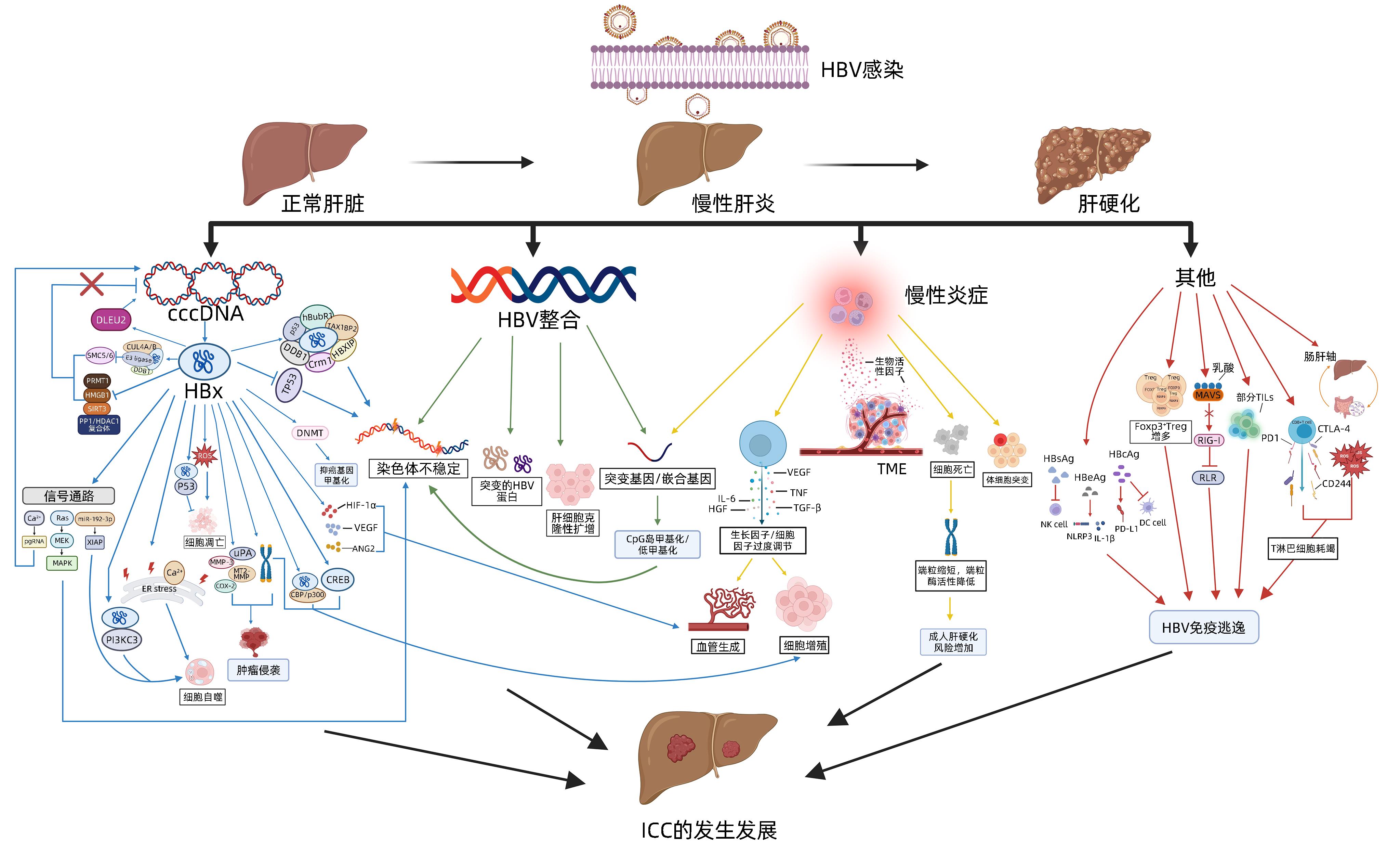乙型肝炎相关肝内胆管癌的发病机制
DOI: 10.12449/JCH240425
利益冲突声明:本文不存在任何利益冲突。
作者贡献声明:田奇玉负责查阅及分析文献,撰写论文;余建负责拟定论文框架及论文修改;黄罡负责指导撰写文章并最终定稿。
-
摘要: 肝内胆管癌(ICC)是原发性肝癌的一种类型,占总病例的10%~15%,发病率和死亡率在全球范围内呈显著上升趋势,尤其是在亚洲国家。目前,根治性切除术是唯一可能治愈ICC的方式,然而术后复发率高,预后较肝细胞癌差。因此,急需进一步研究ICC的发生和发展机制,寻找更有效的治疗手段。一些流行病学数据显示,慢性HBV感染是ICC发生的最主要易感因素之一,然而人们对相关致癌作用知之甚少。本综述总结了二者之间的流行病学证据,简要概述了HBV相关ICC发生发展的机制,以期能有助于更好地了解HBV在ICC发生和发展中的作用。Abstract: Intrahepatic cholangiocarcinoma (ICC) is a type of primary liver cancer that accounts for about 10% — 15% of the total cases, and its incidence and mortality rates tend to increase significantly around the world, especially in Asian countries. At present, radical liver resection is the only possible cure for ICC, but with a fairly high postoperative recurrence rate and a poorer prognosis than hepatocellular carcinoma. Therefore, it is urgently needed to further investigate the mechanisms of the development and progression of ICC and search for more effective treatment methods. Some epidemiological data suggest that chronic hepatitis B virus infection is one of the most important predisposing factors for ICC, yet little is known about its oncogenic effects. This article summarizes the epidemiological evidence that links the two diseases and briefly elaborates on the mechanisms of the development and progression of HBV-associated ICC, so as to help to gain a better understanding of the role of HBV in the development and progression of ICC.
-
Key words:
- Cholangiocarcinoma /
- Hepatitis B virus /
- Carcinogenesis
-
[1] MORIS D, PALTA M, KIM C, et al. Advances in the treatment of intrahepatic cholangiocarcinoma: An overview of the current and future therapeutic landscape for clinicians[J]. CA Cancer J Clin, 2023, 73( 2): 198- 222. DOI: 10.3322/caac.21759. [2] BERTUCCIO P, MALVEZZI M, CARIOLI G, et al. Global trends in mortality from intrahepatic and extrahepatic cholangiocarcinoma[J]. J Hepatol, 2019, 71( 1): 104- 114. DOI: 10.1016/j.jhep.2019.03.013. [3] SUNG H, FERLAY J, SIEGEL R L, et al. Global Cancer Statistics 2020: GLOBOCAN estimates of incidence and mortality worldwide for 36 cancers in 185 countries[J]. CA Cancer J Clin, 2021, 71( 3): 209- 249. DOI: org/10.3322/caac.21660. [4] RUMGAY H, ARNOLD M, FERLAY J, et al. Global burden of primary liver cancer in 2020 and predictions to 2040[J]. J Hepatol, 2022, 77( 6): 1598- 1606. DOI: 10.1016/j.jhep.2022.08.021. [5] TAVOLARI S, BRANDI G. Mutational landscape of cholangiocarcinoma according to different etiologies: A review[J]. Cells, 2023, 12( 9): 1216. DOI: 10.3390/cells12091216. [6] SONG ZM, LIN SR, WU XW, et al. Hepatitis B virus-related intrahepatic cholangiocarcinoma originates from hepatocytes[J]. Hepatol Int, 2023, 17( 5): 1300- 1317. DOI: 10.1007/s12072-023-10556-3. [7] SLAGLE BL, BOUCHARD MJ. Role of HBx in hepatitis B virus persistence and its therapeutic implications[J]. Curr Opin Virol, 2018, 30: 32- 38. DOI: 10.1016/j.coviro.2018.01.007. [8] RIVIÈRE L, GEROSSIER L, DUCROUX A, et al. HBx relieves chromatin-mediated transcriptional repression of hepatitis B viral cccDNA involving SETDB1 histone methyltransferase[J]. J Hepatol, 2015, 63( 5): 1093- 1102. DOI: 10.1016/j.jhep.2015.06.023. [9] DECORSIÈRE A, MUELLER H, van BREUGEL PC, et al. Hepatitis B virus X protein identifies the Smc5/6 complex as a host restriction factor[J]. Nature, 2016, 531( 7594): 386- 389. DOI: 10.1038/nature17170. [10] BELLONI L, POLLICINO T, de NICOLA F, et al. Nuclear HBx binds the HBV minichromosome and modifies the epigenetic regulation of cccDNA function[J]. Proc Natl Acad Sci USA, 2009, 106( 47): 19975- 19979. DOI: 10.1073/pnas.0908365106. [11] SONG GJ, YANG RF, JIN Q, et al. HBV pregenome RNA as a predictor of spontanous HBeAg seroconversion in HBeAg-positive chronic hepatitis B patients[J]. BMC Gastroenterol, 2023, 23( 1): 381. DOI: 10.1186/s12876-023-03023-8. [12] LEE WY, BACHTIAR M, CHOO CCS, et al. Comprehensive review of Hepatitis B Virus-associated hepatocellular carcinoma research through text mining and big data analytics[J]. Biol Rev Camb Philos Soc, 2019, 94( 2): 353- 367. DOI: 10.1111/brv.12457. [13] ZHOU YM, CAO L, LI B, et al. Expression of HBx protein in hepatitis B virus-infected intrahepatic cholangiocarcinoma[J]. Hepatobiliary Pancreat Dis Int, 2012, 11( 5): 532- 535. DOI: 10.1016/s1499-3872(12)60219-7. [14] COUGOT D, ALLEMAND E, RIVIÈRE L, et al. Inhibition of PP1 phosphatase activity by HBx: A mechanism for the activation of hepatitis B virus transcription[J]. Sci Signal, 2012, 5( 205): ra1. DOI: 10.1126/scisignal.2001906. [15] KIM WH, HONG F, JARUGA B, et al. Hepatitis B virus X protein sensitizes primary mouse hepatocytes to ethanol- and TNF-alpha-induced apoptosis by a caspase-3-dependent mechanism[J]. Cell Mol Immunol, 2005, 2( 1): 40- 48. [16] PAN JB, DUAN LX, SUN BS, et al. Hepatitis B virus X protein protects against anti-Fas-mediated apoptosis in human liver cells by inducing NF-kappa B[J]. J Gen Virol, 2001, 82( Pt 1): 171- 182. DOI: 10.1099/0022-1317-82-1-171. [17] WANG P, GUO QS, WANG ZW, et al. HBx induces HepG-2 cells autophagy through PI3K/Akt-mTOR pathway[J]. Mol Cell Biochem, 2013, 372( 1-2): 161- 168. DOI: 10.1007/s11010-012-1457-x. [18] WANG XY, WEI ZQ, CHENG B, et al. Endoplasmic reticulum stress promotes HBV production by enhancing use of the autophagosome/multivesicular body axis[J]. Hepatology, 2022, 75( 2): 438- 454. DOI: 10.1002/hep.32178. [19] LIN Y, WU CC, WANG XY, et al. Hepatitis B virus is degraded by autophagosome-lysosome fusion mediated by Rab7 and related components[J]. Protein Cell, 2019, 10( 1): 60- 66. DOI: 10.1007/s13238-018-0555-2. [20] ZHANG H, ZHANG YQ, ZHU XY, et al. DEAD box protein 5 inhibits liver tumorigenesis by stimulating autophagy via interaction with p62/SQSTM1[J]. Hepatology, 2019, 69( 3): 1046- 1063. DOI: 10.1002/hep.30300. [21] YAN Y, LIU N, LU L, et al. Autophagy enhances antitumor immune responses induced by irradiated hepatocellular carcinoma cells engineered to express hepatitis B virus X protein[J]. Oncol Rep, 2013, 30( 2): 993- 999. DOI: 10.3892/or.2013.2531. [22] SANZ-CAMENO P, MARTÍN-VÍLCHEZ S, LARA-PEZZI E, et al. Hepatitis B virus promotes angiopoietin-2 expression in liver tissue: Role of HBV x protein[J]. Am J Pathol, 2006, 169( 4): 1215- 1222. DOI: 10.2353/ajpath.2006.051246. [23] LEVRERO M, ZUCMAN-ROSSI J. Mechanisms of HBV-induced hepatocellular carcinoma[J]. J Hepatol, 2016, 64( 1 Suppl): S84- S101. DOI: 10.1016/j.jhep.2016.02.021. [24] ZOU SQ, QU ZL, LI ZF, et al. Hepatitis B virus X gene induces human telomerase reverse transcriptase mRNA expression in cultured normal human cholangiocytes[J]. World J Gastroenterol, 2004, 10( 15): 2259- 2262. DOI: 10.3748/wjg.v10.i15.2259. [25] SALERNO D, CHIODO L, ALFANO V, et al. Hepatitis B protein HBx binds the DLEU2 lncRNA to sustain cccDNA and host cancer-related gene transcription[J]. Gut, 2020, 69( 11): 2016- 2024. DOI: 10.1136/gutjnl-2019-319637. [26] DING WB, WANG MC, YU J, et al. HBV/pregenomic RNA increases the stemness and promotes the development of HBV-related HCC through reciprocal regulation with insulin-like growth factor 2 mRNA-binding protein 3[J]. Hepatology, 2021, 74( 3): 1480- 1495. DOI: 10.1002/hep.31850. [27] ZHENG DL, ZHANG L, CHENG N, et al. Epigenetic modification induced by hepatitis B virus X protein via interaction with de novo DNA methyltransferase DNMT3A[J]. J Hepatol, 2009, 50( 2): 377- 387. DOI: 10.1016/j.jhep.2008.10.019. [28] CHEN YY, WANG WH, CHE L, et al. BNIP3L-dependent mitophagy promotes HBx-induced cancer stemness of hepatocellular carcinoma cells via glycolysis metabolism reprogramming[J]. Cancers, 2020, 12( 3): 655. DOI: 10.3390/cancers12030655. [29] CHEN SL, ZHANG CZ, LIU LL, et al. A GYS2/p53 negative feedback loop restricts tumor growth in HBV-related hepatocellular carcinoma[J]. Cancer Res, 2019, 79( 3): 534- 545. DOI: 10.1158/0008-5472.CAN-18-2357. [30] ZHAO LH, WANG Y, TIAN T, et al. Analysis of viral integration reveals new insights of oncogenic mechanism in HBV-infected intrahepatic cholangiocarcinoma and combined hepatocellular-cholangiocarcinoma[J]. Hepatol Int, 2022, 16( 6): 1339- 1352. DOI: 10.1007/s12072-022-10419-3. [31] MASON WS, GILL US, LITWIN S, et al. HBV DNA integration and clonal hepatocyte expansion in chronic hepatitis B patients considered immune tolerant[J]. Gastroenterology, 2016, 151( 5): 986- 998.e4. DOI: 10.1053/j.gastro.2016.07.012. [32] AN J, KIM D, OH B, et al. Comprehensive characterization of viral integrations and genomic aberrations in HBV-infected intrahepatic cholangiocarcinomas[J]. Hepatology, 2022, 75( 4): 997- 1011. DOI.org/10.1002/hep.32135. [33] ZHAO LH, LIU X, YAN HX, et al. Genomic and oncogenic preference of HBV integration in hepatocellular carcinoma[J]. Nat Commun, 2016, 7: 12992. DOI: 10.1038/ncomms12992. [34] JANG JW, KIM HS, KIM JS, et al. Distinct patterns of HBV integration and TERT alterations between in tumor and non-tumor tissue in patients with hepatocellular carcinoma[J]. Int J Mol Sci, 2021, 22( 13): 7056. DOI: 10.3390/ijms22137056. [35] LI XJ, ZHANG JB, YANG ZW, et al. The function of targeted host genes determines the oncogenicity of HBV integration in hepatocellular carcinoma[J]. J Hepatol, 2014, 60( 5): 975- 984. DOI: 10.1016/j.jhep.2013.12.014. [36] HUANG XL, YU D, GU XT, et al. A comparative study of clinicopathological and imaging features of HBV-negative and HBV-positive intrahepatic cholangiocarcinoma patients with different pathologic differentiation degrees[J]. Sci Rep, 2023, 13( 1): 19726. DOI: 10.1038/s41598-023-47108-6. [37] ZOU SS, LI JR, ZHOU HB, et al. Mutational landscape of intrahepatic cholangiocarcinoma[J]. Nat Commun, 2014, 5: 5696. DOI: 10.1038/ncomms6696. [38] SZE KMF, CHU GKY, LEE JMF, et al. C-terminal truncated hepatitis B virus x protein is associated with metastasis and enhances invasiveness by C-Jun/matrix metalloproteinase protein 10 activation in hepatocellular carcinoma[J]. Hepatology, 2013, 57( 1): 131- 139. DOI: 10.1002/hep.25979. [39] FRAGKOU N, SIDERAS L, PANAS P, et al. Update on the association of hepatitis B with intrahepatic cholangiocarcinoma: Is there new evidence?[J]. World J Gastroenterol, 2021, 27( 27): 4252- 4275. DOI: 10.3748/wjg.v27.i27.4252. [40] GATSELIS NK, TEPETES K, LOUKOPOULOS A, et al. Hepatitis B virus and intrahepatic cholangiocarcinoma[J]. Cancer Investig, 2007, 25( 1): 55- 58. DOI: 10.1080/07357900601130722. [41] CALADO RT, BRUDNO J, MEHTA P, et al. Constitutional telomerase mutations are genetic risk factors for cirrhosis[J]. Hepatology, 2011, 53( 5): 1600- 1607. DOI: 10.1002/hep.24173. [42] SHEN YF, XU SS, YE CQ, et al. Proteomic and single-cell landscape reveals novel pathogenic mechanisms of HBV-infected intrahepatic cholangiocarcinoma[J]. iScience, 2023, 26( 2): 106003. DOI: 10.1016/j.isci.2023.106003. [43] ILYAS SI, AFFO S, GOYAL L, et al. Cholangiocarcinoma-novel biological insights and therapeutic strategies[J]. Nat Rev Clin Oncol, 2023, 20( 7): 470- 486. DOI: 10.1038/s41571-023-00770-1. [44] GONG J, LIANG YL, ZHOU WY, et al. Prognostic value of neutrophil-to-lymphocyte ratio associated with prognosis in HBV-infected patients[J]. J Med Virol, 2018, 90( 4): 730- 735. DOI: 10.1002/jmv.25015. [45] ZHENG BH, MA JQ, TIAN LY, et al. The distribution of immune cells within combined hepatocellular carcinoma and cholangiocarcinoma predicts clinical outcome[J]. Clin Transl Med, 2020, 10( 1): 45- 56. DOI: 10.1002/ctm2.11. [46] MA BQ, MENG HJ, TIAN Y, et al. Distinct clinical and prognostic implication of IDH1/2 mutation and other most frequent mutations in large duct and small duct subtypes of intrahepatic cholangiocarcinoma[J]. BMC Cancer, 2020, 20( 1): 318. DOI: 10.1186/s12885-020-06804-6. [47] KOHANBASH G, CARRERA DA, SHRIVASTAV S, et al. Isocitrate dehydrogenase mutations suppress STAT1 and CD8+ T cell accumulation in gliomas[J]. J Clin Invest, 2017, 127( 4): 1425- 1437. DOI: 10.1172/JCI90644. [48] KENDALL T, VERHEIJ J, GAUDIO E, et al. Anatomical, histomorphological and molecular classification of cholangiocarcinoma[J]. Liver Int, 2019, 39( Suppl 1): 7- 18. DOI: 10.1111/liv.14093. [49] TJWA ETTL, VAN OORD GW, HEGMANS JP, et al. Viral load reduction improves activation and function of natural killer cells in patients with chronic hepatitis B[J]. J Hepatol, 2011, 54( 2): 209- 218. DOI: 10.1016/j.jhep.2010.07.009. [50] FISICARO P, BARILI V, MONTANINI B, et al. Targeting mitochondrial dysfunction can restore antiviral activity of exhausted HBV-specific CD8 T cells in chronic hepatitis B[J]. Nat Med, 2017, 23( 3): 327- 336. DOI: 10.1038/nm.4275. [51] TENG CF, LI TC, WANG T, et al. Increased infiltration of regulatory T cells in hepatocellular carcinoma of patients with hepatitis B virus pre-S2 mutant[J]. Sci Rep, 2021, 11( 1): 1136. DOI: 10.1038/s41598-020-80935-5. [52] YU X, LAN PX, HOU XB, et al. HBV inhibits LPS-induced NLRP3 inflammasome activation and IL-1β production via suppressing the NF-κB pathway and ROS production[J]. J Hepatol, 2017, 66( 4): 693- 702. DOI: 10.1016/j.jhep.2016.12.018. [53] LI M, ZHOU ZH, SUN XH, et al. Hepatitis B core antigen upregulates B7-H1 on dendritic cells by activating the AKT/ERK/P38 pathway: A possible mechanism of hepatitis B virus persistence[J]. Lab Invest, 2016, 96( 11): 1156- 1164. DOI: 10.1038/labinvest.2016.96. [54] ZHOU L, HE R, FANG PN, et al. Hepatitis B virus rigs the cellular metabolome to avoid innate immune recognition[J]. Nat Commun, 2021, 12( 1): 98. DOI: 10.1038/s41467-020-20316-8. [55] FISICARO P, BONI C, BARILI V, et al. Strategies to overcome HBV-specific T cell exhaustion: Checkpoint inhibitors and metabolic re-programming[J]. Curr Opin Virol, 2018, 30: 1- 8. DOI: 10.1016/j.coviro.2018.01.003. [56] YAN FN, ZHANG Q, SHI K, et al. Gut microbiota dysbiosis with hepatitis B virus liver disease and association with immune response[J]. Front Cell Infect Microbiol, 2023, 13: 1152987. DOI: 10.3389/fcimb.2023.1152987. -



 PDF下载 ( 977 KB)
PDF下载 ( 977 KB)


 下载:
下载:


